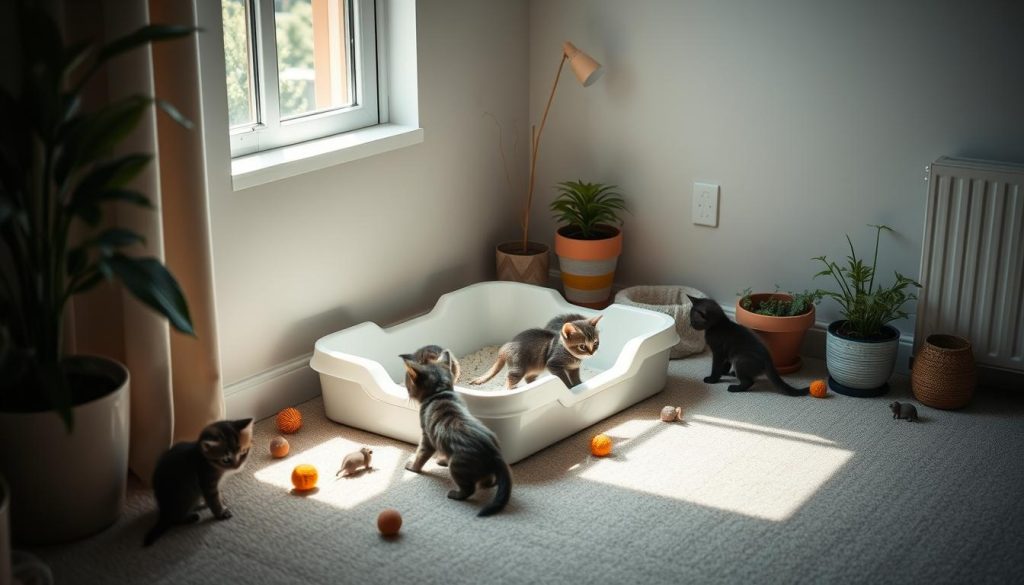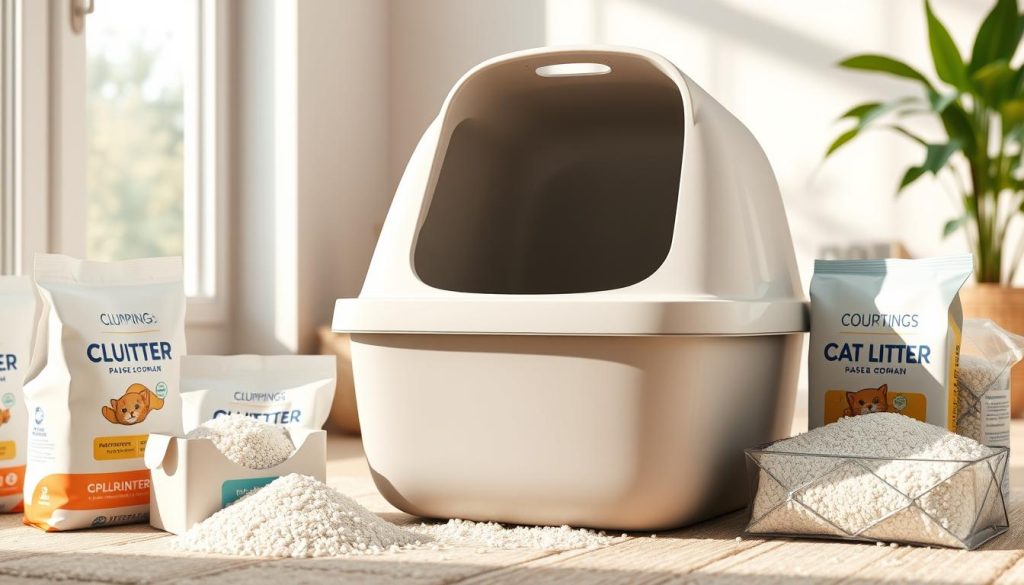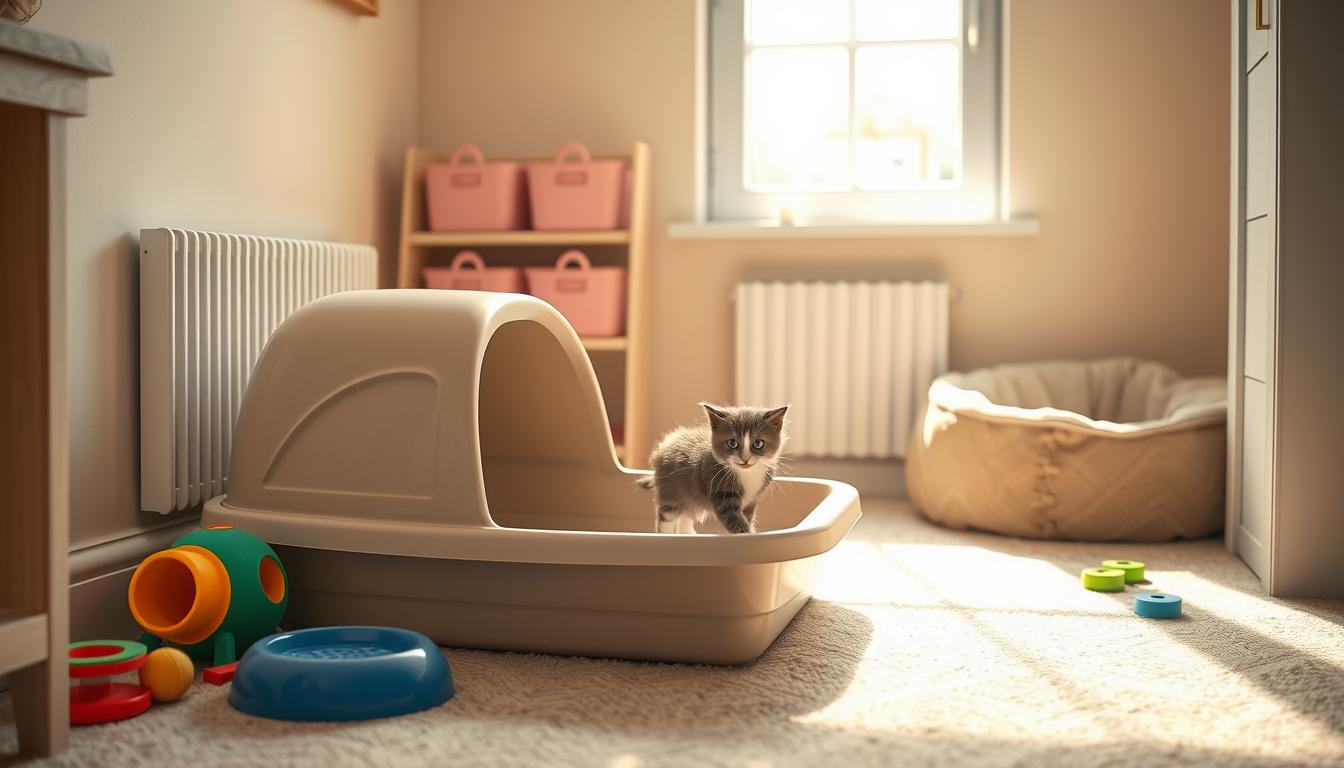As a devoted cat parent, I know how key successful cat litter box training is. In this article, I’ll share tips and a step-by-step guide. These will help your feline friend adjust to the litter box easily. Whether it’s a new kitten or an adult cat, these strategies will help you succeed.
Proper cat litter box training keeps your home clean and your cat happy and healthy. Understanding its importance and following the right steps can prevent litter box problems. I’ll cover the key factors, from choosing the right litter box and litter to solving any issues that come up.
So, let’s start your journey to successful cat litter box training. With the right approach and techniques, you can help your cat use the litter box smoothly. This will make your home a peaceful and stress-free place for everyone.
Understanding the Importance of Litter Box Training
Proper litter box training is key for your cat’s health and your own. Cats that aren’t trained might pee or poop where they shouldn’t. This can cause fights and health issues like urinary tract infections.
Why Proper Training is Crucial for Pet Owners
Training your cat to use the litter box is more than keeping your home clean. It’s about being a responsible pet owner. Cats that don’t use the litter box can damage your home and upset you. It can also harm your relationship with your cat and pose health risks.
Common Litter Box Issues and Their Impact
- Inappropriate urination or defecation: This can result in odors, stains, and damage to your home, as well as potential conflicts with your cat.
- Increased risk of medical problems: Untrained cats are more susceptible to developing urinary tract infections and other health issues.
- Behavioral problems: Lack of litter box training can lead to stress, anxiety, and other behavioral issues in cats.
Understanding the importance of litter box training helps you and your cat live better together. It tackles common litter box problems and ensures a happy, healthy life for your pet. Proper litter box training is essential for pet care and greatly affects the consequences of improper litter box training.
Cat Litter Box Training: A Step-by-Step Guide

Teaching your cat to use the litter box can seem hard. But, with the right steps, it can be easy and successful. This guide will show you how to help your cat learn to use the litter box.
First, place the litter box in a quiet, easy-to-reach spot. Pick a place that’s not too busy and big enough for your cat. Use a good, unscented litter.
- Start by letting your cat get used to the litter box. Put them in it a few times a day. This helps them feel comfortable.
- Watch how your cat acts naturally. Cats like to bury their waste. So, gently cover any waste with litter to encourage this.
- Make using the litter box a good thing. Give treats or praise when your cat uses it. This makes them think it’s a positive thing.
- Keep going, even if it takes time. It might take a while for your cat to get used to it. But, keep training and rewarding them.
By following these steps, you can help your cat learn to use the litter box well. Remember, every cat is different. Be ready to change your approach if needed to find what works best for your cat.
| Step | Action | Tip |
|---|---|---|
| 1 | Set up the litter box in a quiet, accessible location | Choose a spot that is away from high-traffic areas and easy for your cat to access |
| 2 | Gradually introduce your cat to the litter box | Place your cat in the box a few times a day to allow them to explore and get used to the new environment |
| 3 | Observe your cat’s natural instincts | Gently cover any waste with litter to encourage your cat’s natural desire to bury their waste |
| 4 | Positively reinforce litter box use | Offer treats or praise whenever your cat uses the litter box to associate the behavior with a positive outcome |
| 5 | Be patient and consistent | It may take time for your cat to fully embrace the litter box, so stick with the training process and adjust your approach as needed |
Choosing the Right Litter Box and Litter

Choosing the right litter box and litter is key to your cat’s litter box training success. There are many factors to consider for your cat’s comfort and your peace of mind. The best litter box for cats depends on several important factors.
Factors to Consider When Selecting a Litter Box
The size and shape of the litter box are very important. It should be big enough for your cat to move around and dig. Also, make sure it’s easy for your cat to get in and out.
Some cats like covered litter boxes, while others prefer open ones. Think about what your cat likes best.
Types of Litter and Their Pros and Cons
Choosing the right cat litter is also crucial. There are many types of litter, each with its own good and bad points. Clumping litter is popular because it’s easy to clean, but some cats like the softness of non-clumping litter.
Consider things like odor control, dust levels, and if it’s eco-friendly. These factors help you pick the best litter for your cat.
By carefully choosing the right litter box and litter, you can make a comfortable space for your cat. This can help a lot with your litter box training efforts.
Cat Litter Box Training Tips and Tricks
Getting your cat to use the litter box right is more than just setting it up. A few smart tips can make training easier for both you and your cat. As someone who’s been through it, I’ve learned that these methods really help. They make your cat’s litter box use better and cut down on problems.
One key tip is to make the litter box a good place for your cat. Give them treats or praise when they use it correctly. This makes them think the litter box is a good spot. Also, be patient and keep at it. Training might take time, but being consistent is important. Keep a regular schedule and guide your cat to the litter box when they need it, like after eating or sleeping.
Try different litters and places for the litter box to see what your cat likes best. Some cats like unscented litter, while others prefer a deeper layer. Where you put the litter box matters too. Cats like quiet, easy-to-get-to spots. By meeting your cat’s needs, you can make the litter box a welcoming place.

